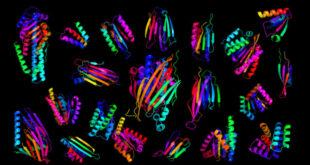The green-tea polyphenol Epigallocatechin gallate (EGCG) may be of particular benefit to patients struggling with amyloidosis and multiple myeloma, according to an international team of researchers led by Washington University in St. Louis. The research is published in the Journal of Biological Chemistry.
According to Kathrin Andrich et al, the Epigallocatechin gallate — a compound found in green tea leaves — may be of particular benefit to patients struggling with multiple myeloma and amyloidosis. Image credit: Ascyrafft Adnan.
Patients with amyloidosis or multiple myeloma are susceptible to a rare condition known systemic light chain amyloidosis (AL), in which parts of the body’s own antibodies become misshapen and can accumulate in various organs, including the heart and kidneys.
AL is the most common form of systemic amyloidosis, but it is still a rare disease with an incidence of 6-7 in one million people.
Dr. Jan Bieschke, lead author on the study and a researcher in the School of Engineering Applied Science at Washington University in St. Louis, and his colleagues from the United States and Germany wanted to better understand how AL works, and how the EGCG — a polyphenol found in the leaves of green tea (Camellia sinensis) — affects the light chain protein.
The researchers isolated individual light chains from nine patients with bone marrow disorders that caused multiple myeloma or amyloidosis. They then ran lab experiments to determine how the EGCG, also known as Epigallocatechin-3-gallate, affected this specific protein.
The authors previously examined EGCG’s effect in both Parkinson’s and Alzheimer’s disease, and found it prevented dangerous buildups of protein present in both diseases.
They had a similar conclusion in this study: in bone marrow patients, the EGCG transformed light chain amyloid, preventing the misshapen form from replicating and accumulating dangerously.
“In the presence of green tea, the chains have a different internal structure,” Dr. Bieschke said.
“The ECGC pulled the light chain into a different type of aggregate that wasn’t toxic and didn’t form fibril structures, as happens to organs affected by amyloidosis.”
The team is now looking at the mechanism of the protein in a test tube.
“We are studying how it works on a foundational level. At the same time, clinical trials at the Amyloidosis Center in Heidelberg, with Alzheimer’s in Berlin and with Parkinson’s in China examine the process in people. We all want this compound to work in a patient,” Dr. Bieschke said.
_____
Kathrin Andrich et al. Aggregation of Full Length Immunoglobulin Light Chains from AL Amyloidosis Patients is Remodeled by Epigallocatechin-3-gallate. Journal of Biological Chemistry, published online December 28, 2016; doi: 10.1074/jbc.M116.750323
 #Bizwhiznetwork.com Innovation ΛI |Technology News
#Bizwhiznetwork.com Innovation ΛI |Technology News




